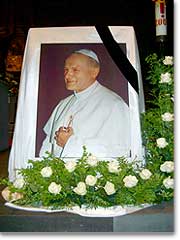 |
|
En agradecida memoria In grateful memory In dankbarer Erinnerung Foto: POS Fischer © 2005 |
|
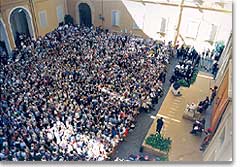 |
|
La familia de Schoenstatt internacional con el Santo Padre, 9 de septiembre de 2004 The international Schoenstatt family with the Holy Father, September 9, 2004 Die internationale Schönstattfamilie beim Papst, 9. September 2004 |
|
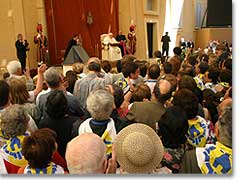 |
|
Misión y compromiso Mission and commitment Sendung und Verpflichtung |
|
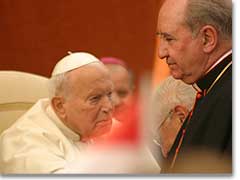 |
|
El Cardenal Francisco Javier Erráuzuriz saluda al Santo Padre, 9 de septiembre de 2004 Cardinal Francisco Javier Errázuriz greets the Pope, september 9, 2004 Kardinal Francisco Javier Errázuriz grüßt den Papst, 9. September 2004 Fotos: Raid/Mari © 2005 |
|
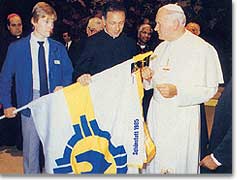 |
|
|
In septiembre de 1985, la Familia Internacional de Schoenstatt tiene una audiencia con Juan Pablo II. Le presente la persona, obra y misión del Padre José Kentenich y se compromete con su amor a la Iglesia. In september 1985, the International Schoenstatt Family has an audience with John Paul II and presents life, work and mission of Father Kentenich to him, committing itself to his love for the church. Im September 1985 begegnet die internationale Schönstattfamilie dem Heiligen Vater, Papst Johannes Paul II, stellt ihm Person, Werk und Sendung ihres Gründers Pater Josef Kentenich vor und erklärt ihre Bereitschaft, die Anliegen des Vaters der Christenheit aufzunehmen und mitzutragen. |
|
Foto: Archiv © 2005 |
In communion with the universal Church, we express our deep sorrow at the departure of John Paul II to the home of the Father. In this farewell hour, we want to recall the living memory of the precious heritage he left us and assure its fruitfulness by renewing our pledge of unity. His historic service to the Church and humanity has multiple facets; we want to emphasize some aspects that we believe have had particular impact.
Whenever a loved one departs, the treasured moments of time spent in family togetherness are called to heart and mind: the beatification of Charles Leisner in Berlin, the various audiences, and eucharistic celebrations with communities and pilgrims of our movement. Above all, we cannot forget his paternal welcome and his wise teachings of September 1985 when he received thousands of members of the International Schoenstatt Family who were united for the centennial celebration of the Founder, Father Joseph Kentenich. On that occasion we renewed before him the promise that Father Kentenich had made to his predecessor Pope Paul VI in 1965: to join forces with all our strength for the renewal of the Church according to the Vatican Council II program. We cannot forget that a few months ago – in September of last year – we met with him again one day after the blessing of the "Matri Ecclesiae" Schoenstatt Shrine built in the suburbs of Rome. In spite of being noticeably hindered by illness and physical weakness, he met with us and granted us the joy and privilege of his presence, his words, and his blessing.
It has been a great gift for us to participate in the Holy Father’s personal experience with the living God. John Paul II was a man of prayer and contemplation, a man of the Eucharist and a sign of the presence of God among us. The doctrine was alive in him and truth was personified in him. This gave him an undeniable moral authority that surpassed the limits of the Catholic Church and established him as a true leader of humanity beyond the many racial, political or religious differences. The consistency of his teaching and personal testimony is also the key to understanding the mutual empathy, affection, and profound understanding between the Holy Father and the youth. Millions of youth met at the World Youth Days of the past and they had eagerly hoped to meet him again in Cologne. They are the future of the Church and humanity; they were not defrauded in their search for a clear orientation and firm support.
John Paul II gave honor to the name he chose as Pope. He embodied and united within himself the intimate and ardent love of his namesakes: John, the beloved disciple, and Paul, the missionary of the people. In the same way he gave honor to the name we normally give the pope: Holy Father. He not only reminded us of the vocation of sanctity we received in Baptism and revealed to us a "pedagogy of sanctity", but he led us on that road and gave us the example of a holy life. Truly we also call him Father. As Father, he shared the joys and sadness of his children and of all peoples. Even when ill and weak, he was unwavering in his willing service and went forth to seek others, especially the poorest and most needy. He is Father because he did not cause differences nor did he allow himself to be taken in by opportunism and conveniences. He valued each culture and knew how to raise them up. He benevolently denounced their errors and pointed out their dangers. In all of these many ways, he showed us that his fatherhood knew no bounds.
He had an intuitive grasp of the signs of the Holy Spirit’s action in hearts and communities and he was a great teacher of the Gospel. Firm and clear in announcing the truth, he above all tirelessly sowed and creatively promoted numerous initiatives to effectively represent that truth and appropriately transmit it according to the sensitivity of man and the contemporary cultures. He knew well that faith is a life long process and that it requires the accompaniment of patience, willingness to dialogue, truth and respect.
His appraisal of the ecclesiae movements as fruits of the Spirit and the Springtime of Church calls us to keep alive our unique charisma and to place it at the service of all the ecclesiastic community. The unforgettable celebration in St. Peter's Square on the eve of the Feast of Pentecost in 1998 increased the harmony of the movements among themselves and awakened new momentum for future encounters and collaboration. He reiterated the call to be Church and to live as a mystery of communion and of mission with all the people of God.
He announced in his first encyclical that the road of the Church should be man – man in his concrete and unique existence, created in the image of God and redeemed by the blood of Christ. He never abandoned that road and he walked it until the end. That is why he was the great guardian of the dignity of each individual and of all humankind. That is why he defended the sacred value of life from the moment of conception until the final moment of death. That is why he wanted to be known as the pope of the family – the very cell of the human personality. That is why in him, peace and justice found the most avid advocate. Without them there is no life that conforms to the dignity of man. It is not surprising that millions of men and women of all religions and races echoed such a message and today they experience the departure of John Paul II as a sorrowful loss for all of humanity. "Open the doors to Christ, do not be afraid" was his first and continuous call as a universal pastor who was urged by the conviction that history will only be fully realized in Jesus Christ.
The way of man and the way of the Church have the same goal: to encounter the Father, the God rich in mercy forever manifesting his love for us through his Son, Redeemer of man and Lord of history, and enlivening and sanctifying us through the Holy Spirit. This was the goal pointed out by John Paul II at the beginning of the new millennium of history. He encouraged us to walk toward the goal with our eyes fixed upon the face of Christ, to follow his word, to cast out into the deep sea without fear of the turmoil of our time, and to bravely offer his message to all men and to all people.
Something essential would be lacking in our grateful memory of the person and magisterium of John Paul II if we forgot a name and a message: Mary. "Totus tuus" was much more than a public declaration of a personal piety. He consecrated his love to Her from his infancy until the end of his days. She accompanied him like a good mother and protected him when an attempt was made against his life. She was his constant source of encouragement. He was convinced that no one but Mary could as profoundly guide us and teach us to live the mystery of Christ in our human dimension. His pilgrimage to so many Marian shrines enriched the geography of faith throughout the world and constituted a non-negotiable part of his schedule on the apostolic trips. We are honored that in 1991 he blessed the Schoenstatt Shrine on his native soil in Koszalin, Poland. We also are honored that in December of the Holy Year 2000, he went on pilgrimage to the "Cor Ecclesiae" Schoenstatt Shrine, located a few kilometers from the Basilica of St. Peter's.
We praise the one Triune God for the gift given to us in the person and magisterium of John Paul II. We pray for the strength to carry out the mission and message he entrusted to us and we invoke the Holy Spirit, asking that the next successor of Peter will again be a blessing for the Church and world.
Schoenstatt, April 5, 2005
Father Heinrich Walter
President of the General Presidium of the International Schoenstatt Work